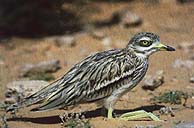Hot
Spots for Bird Watchers
by Dr. Mike Evans
Picture by NCWCD
 When
I started my new job at the headquarters of BirdLife International in Cambridge,
UK, two and a half years ago, my enthusiasm for the new project facing
me was mingled with more than a little trepidation. Lying before me, on
my desk, was a bright orange and rather dauntingly thick paperback book,
Important Bird Areas in Europe, whose 888 pages described 2,444 of the
most important sites for birds in 32 European countries. The publication
of the book had helped to focus the efforts of bird conservation groups
throughout Europe and had been widely cited as a successful marriage between
science and management in wildlife conservation.
When
I started my new job at the headquarters of BirdLife International in Cambridge,
UK, two and a half years ago, my enthusiasm for the new project facing
me was mingled with more than a little trepidation. Lying before me, on
my desk, was a bright orange and rather dauntingly thick paperback book,
Important Bird Areas in Europe, whose 888 pages described 2,444 of the
most important sites for birds in 32 European countries. The publication
of the book had helped to focus the efforts of bird conservation groups
throughout Europe and had been widely cited as a successful marriage between
science and management in wildlife conservation.My own task was to co-ordinate the completion of a similar kind of book for the Middle East, as part of BirdLife International's longer term aim to identify all of the important bird areas in the world before the end of the millennium. Important Bird Areas of the Middle East had been on the drawing board as a project proposal for a number of years, and had finally secured funding from the Royal Society for the Protection of Birds, the BirdLife International partner in the UK, after money had been donated by its members and by the general public following the emergency created by the Gulf War oil pollution.
Any wildlife conservation action today usually has as its ultimate aim one of three different targets, all of them being necessary and complementary: the conservation of species, sites, and ecosystems. The IBA book is designed as an aid to the second approach, site conservation. For many countries in the Middle East, a large amount of information has accumulated regarding which birds occur at which sites, but this is distributed within many different books, journals, note-books and other even more arcane sources, often unpublished or only available with difficulty. The aim of the IBA project was to sort through this huge and unmanageable mass of information, so as to come up with a clear and up to date picture of the priorities for site conservation in the Middle East, to provide guidance to all people and agencies planning to take actions to conserve birds and other wildlife in the region. The project aimed to answer questions such as: which are the most important sites, why are they important, where are they, which ones are safe for the moment and which are immediately threatened, and so on.
But how does one choose which are the most "important" sites for birds, or decide that a site is "not important", in a way that can be accepted by all parties? This is partly a question of scale, and BirdLife International decided that its role was to identify and list only those sites which were important on a regional (Middle Eastern) or global level, excluding those sites which were important at a local or national level.
After consultations in the region, sites were considered "important" if they supported species threatened with global extinction (Red Data Book species) or with extinction in the Middle East, or if they supported particularly large numbers of a species (usually waterfowl or seabirds, since these show the greatest tendency to congregate at sites), or if they supported particularly good numbers of Middle Eastern `endemic' birds, i.e. those species whose world populations are restricted to the Middle East and for which the Middle Eastern countries therefore have most responsibility for preserving, in any contribution to maintaining global biodiversity.
CLICK ON DIAGRAM TO ENLARGE (54k JPEG)
The variety of sites in the inventory was eye-opening, even to someone who has worked and travelled in the Middle East. It is perhaps invidious to single out any for special mention, since they are all equally important in their own ways. However, some of them stick particularly in my memory, even though I haven't visited them. The ice-age refuge of Shallal ad-Dahna, high in the Asir mountains of Saudi Arabia, with its juniper woodland, permanent streams and relict populations of northern, temperate zone animals such as the magpie. Or the rocky, monsoon lashed coast of southern Oman with its unique cold water up welling offshore, which supports kelp beds, abalones and possibly even breeding humpback whales - sounding more like northern California than Arabia.
Publication of Important Bird Areas in the Middle East should add further emphasis to the efforts already underway throughout the region to conserve the natural heritage of the Middle East.
Contents | News | Book Reviews | Back Issues| Forum |
Subjects |
Search | Current Issue | Subscribe
Arabian Wildlife. Volume 2, Number 1